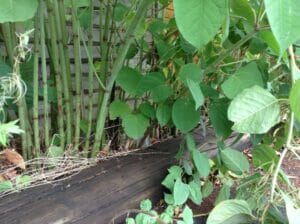Selling a house is known to be a stressful process, you’d be very lucky to get through the whole process without any hiccups along the way. Some problems are well-known and take little time to resolve, whilst others can be more of a head scratcher, leaving sellers needing advice, help and a resolution. Finding out you have Japanese knotweed in your back garden fits this category. So, why is Japanese knotweed bad news for property sellers?
Why is Japanese knotweed considered so bad?
Since the early 2000’s, Japanese knotweed has gained the reputation of a physically destructive plant. Examples of the problems reportedly caused by Japanese knotweed include damage to house foundations, breaking through cracks into drains, and instances of damage and destruction to sheds, fence walls and drives. After numerous reports of this type, mortgage lenders started to take note, and the media frenzy soon gained momentum.
Within a few years, a good chunk of the population believed that wherever Japanese knotweed was present, severe damage was bound to follow, even to solidly constructed walls and materials as strong as concrete. Property values were sometimes downgraded and the presence of Japanese knotweed became a misused bargaining tool. With lenders seemingly happy to go along with the reputation that had been created, house sales involving knotweed became a whole lot harder as potential buyers spotted a new way to drive a hard bargain. In reality, the damage knotweed produces, as we’ll discuss later, is far more nuanced.
Does Japanese knotweed complicate the selling process?
We’re often asked the question, do sellers have to disclose Japanese knotweed? In short, yes. During the preparations for your sale, one of the things you’ll have to do is complete the ‘TA6’ form. This asks directly about the presence of Japanese knotweed at the property. It is important that you answer this honestly and accurately – the consequences of not doing so can be quite severe. The worst-case scenario is a court case and an order to pay compensation and costs. In the highly publicised 2023 knotweed case of Downing v Henderson, the defendant was ordered to pay £200,000 to cover legal costs and damages after the judge was not satisfied with the defendant’s representation of the facts.
Despite this, there has been a shift in how the risk from knotweed is assessed and selling a house with Japanese knotweed can be pretty straightforward; there is a well-established route to keeping your house sale on track.

The new RICS knotweed Guidance
Released early in 2022, the revised RICS professional standard on Japanese knotweed has been a big help. The well-known ‘seven metre rule’ has been replaced with a more optimistic approach, citing three metres as the distance within which Japanese knotweed should be considered a reportable threat to a property. There is also updated guidance on the physical management of knotweed, with the recommendation to bring in a specialist contractor a feature throughout. Pressure had been building on the RICS to review their older documentation following a government inquiry and new research, as well as voices within the industry who had been arguing against the hype for some time. The hope is that the relaxation of ‘the rules’ will continue to calm nerves all round, and that lenders especially will continue the trend towards a more pragmatic approach.
Examples of Japanese knotweed damage
Examples of the damage Japanese knotweed is reportedly capable of are: cracked brickwork and drains, swamped sheds, walls pushed over, lifted paving and broken-up tarmac. However, these cases really are the exception and, when damage occurs, it’s normally because of a pre-existing weakness.
Why Japanese knotweed isn’t so bad anymore
The topic of whether Japanese knotweed is responsible for damage has been studied in extensive detail by Dr. Karen Bacon and Dr. Mark Fennel, two highly regarded academics with lots of field experience. They looked at real world scenarios and gathered data from professional organisations, coming to the conclusion that Japanese knotweed damage to buildings and other structures was rare. The study findings pointed out that many other plants are more likely to cause damage, with trees being the obvious example.
“While evidence was found to support the claim that trees can cause major damage, no such evidence could be found for F. japonica*.” The conclusion of the study said, “The biology of F. japonica makes it less capable of causing significant structural damage than many woody plant species. This conclusion has been reached for all three of the main mechanisms by which plants are known to cause structural damage: subsidence (indirect); collapse and impact (direct); and accumulating pressure due to growth (direct). There is essentially no support for F. japonica as a major cause of damage to property in the literature, and this study found that F. japonica is less likely to cause damage than other common species.”
The study was clear in stating that Japanese knotweed is not a plant to be feared. In another part of Bacon and Fennel’s assessment, they point out that amenity space is found to be affected in many cases. This backs up what we at PBA Solutions have said for many years and should be the focus for lenders.
Japanese knotweed is capable of spreading across garden spaces, intermingling with other planting and popping up across lawns. It thrives on disturbance and mismanagement. It can wreck small gardens. Once established in the soil, it’s very hard to eradicate. Full removal of Japanese knotweed can be achieved through professional excavation but the cost of removing knotweed waste soil is very high (it’s classed as Controlled Waste). When Japanese knotweed causes big problems for homeowners, those problems are normally garden space related.
Generally, lenders have become more pragmatic about Japanese knotweed and its negative effects over the years. Now, most lenders are willing to lend as long as some important criteria are fulfilled.
Using a specialist contractors
Typically, by finding a specialist contractor like PBA Solutions, you can satisfy your lender with a professional survey, knotweed management plan and treatment programme, not forgetting the all-important ten-year insurance-backed guarantee from the contractor. Yes, it’s a complication that may cause a slight delay but it’s better, easier and far more effective than trying to satisfy the buyer and lender by controlling Japanese knotweed yourself. Of course, there is a cost attached to putting the necessary things in place but, compared to the value of most properties these days, dealing responsibly with a Japanese knotweed infestation is a very small price to pay.
Don’t allow your property sale to be derailed, if you need help or advice about Japanese knotweed call 0203 174 2187 or 01202 816134 to talk to one of our consultants today.
* F.Japonica refers to Fallopia Japanica, the scientific name for Japanese knotweed up to a few years ago, when it was changed to Reynoutria Japonica.

